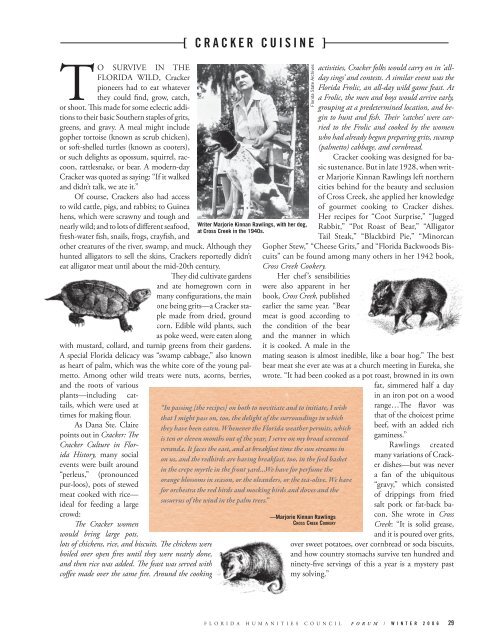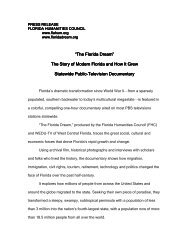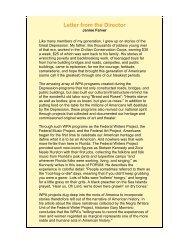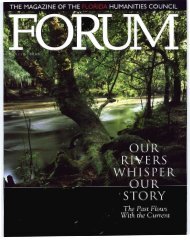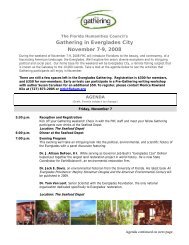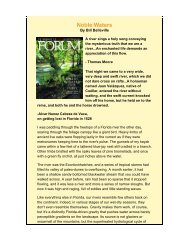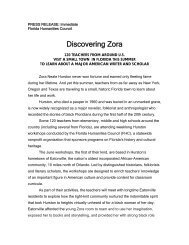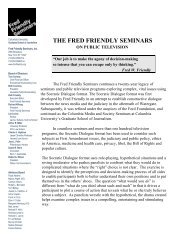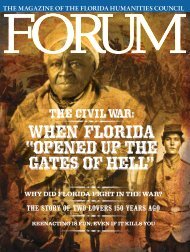THE MAGAZINE OF THE FLORIDA HUMANITIES COUNCIL
THE MAGAZINE OF THE FLORIDA HUMANITIES COUNCIL
THE MAGAZINE OF THE FLORIDA HUMANITIES COUNCIL
Create successful ePaper yourself
Turn your PDF publications into a flip-book with our unique Google optimized e-Paper software.
TO SURVIVE IN <strong>THE</strong><br />
<strong>FLORIDA</strong> WILD, Cracker<br />
pioneers had to eat whatever<br />
they could find, grow, catch,<br />
or shoot. This made for some eclectic additions<br />
to their basic Southern staples of grits,<br />
greens, and gravy. A meal might include<br />
gopher tortoise (known as scrub chicken),<br />
or soft-shelled turtles (known as cooters),<br />
or such delights as opossum, squirrel, raccoon,<br />
rattlesnake, or bear. A modern-day<br />
Cracker was quoted as saying: “If it walked<br />
and didn’t talk, we ate it.”<br />
Of course, Crackers also had access<br />
to wild cattle, pigs, and rabbits; to Guinea<br />
hens, which were scrawny and tough and<br />
nearly wild; and to lots of different seafood,<br />
fresh-water fish, snails, frogs, crayfish, and<br />
other creatures of the river, swamp, and muck. Although they<br />
hunted alligators to sell the skins, Crackers reportedly didn’t<br />
eat alligator meat until about the mid-20th century.<br />
They did cultivate gardens<br />
and ate homegrown corn in<br />
many configurations, the main<br />
one being grits—a Cracker staple<br />
made from dried, ground<br />
corn. Edible wild plants, such<br />
as poke weed, were eaten along<br />
with mustard, collard, and turnip greens from their gardens.<br />
A special Florida delicacy was “swamp cabbage,” also known<br />
as heart of palm, which was the white core of the young palmetto.<br />
Among other wild treats were nuts, acorns, berries,<br />
and the roots of various<br />
plants—including cat-<br />
tails, which were used at<br />
times for making flour.<br />
As Dana Ste. Claire<br />
points out in Cracker: The<br />
Cracker Culture in Florida<br />
History, many social<br />
events were built around<br />
“perleus,” (pronounced<br />
pur-loos), pots of stewed<br />
meat cooked with rice—<br />
ideal for feeding a large<br />
crowd:<br />
The Cracker women<br />
would bring large pots,<br />
lots of chickens, rice, and biscuits. The chickens were<br />
boiled over open fires until they were nearly done,<br />
and then rice was added. The feast was served with<br />
coffee made over the same fire. Around the cooking<br />
[ C R A C K E R C U I S I N E ]<br />
Writer Marjorie Kinnan Rawlings, with her dog,<br />
at Cross Creek in the 1940s.<br />
“In passing [the recipes] on both to novitiate and to initiate, I wish<br />
that I might pass on, too, the delight of the surroundings in which<br />
they have been eaten. Whenever the Florida weather permits, which<br />
is ten or eleven months out of the year, I serve on my broad screened<br />
veranda. It faces the east, and at breakfast time the sun streams in<br />
on us, and the redbirds are having breakfast, too, in the feed basket<br />
in the crepe myrtle in the front yard…We have for perfume the<br />
orange blossoms in season, or the oleanders, or the tea-olive. We have<br />
for orchestra the red birds and mocking birds and doves and the<br />
susurrus of the wind in the palm trees.”<br />
Florida State Archives<br />
activities, Cracker folks would carry on in ‘allday<br />
sings’ and contests. A similar event was the<br />
Florida Frolic, an all-day wild game feast. At<br />
a Frolic, the men and boys would arrive early,<br />
grouping at a predetermined location, and begin<br />
to hunt and fish. Their ‘catches’ were carried<br />
to the Frolic and cooked by the women<br />
who had already begun preparing grits, swamp<br />
(palmetto) cabbage, and cornbread.<br />
Cracker cooking was designed for basic<br />
sustenance. But in late 1928, when writer<br />
Marjorie Kinnan Rawlings left northern<br />
cities behind for the beauty and seclusion<br />
of Cross Creek, she applied her knowledge<br />
of gourmet cooking to Cracker dishes.<br />
Her recipes for “Coot Surprise,” “Jugged<br />
Rabbit,” “Pot Roast of Bear,” “Alligator<br />
Tail Steak,” “Blackbird Pie,” “Minorcan<br />
Gopher Stew,” “Cheese Grits,” and “Florida Backwoods Biscuits”<br />
can be found among many others in her 1942 book,<br />
Cross Creek Cookery.<br />
Her chef’s sensibilities<br />
were also apparent in her<br />
book, Cross Creek, published<br />
earlier the same year. “Bear<br />
meat is good according to<br />
the condition of the bear<br />
and the manner in which<br />
it is cooked. A male in the<br />
mating season is almost inedible, like a boar hog.” The best<br />
bear meat she ever ate was at a church meeting in Eureka, she<br />
wrote. “It had been cooked as a pot roast, browned in its own<br />
fat, simmered half a day<br />
in an iron pot on a wood<br />
—Marjorie Kinnan Rawlings<br />
Cross Creek Cookery<br />
range…The flavor was<br />
that of the choicest prime<br />
beef, with an added rich<br />
gaminess.”<br />
Rawlings created<br />
many variations of Cracker<br />
dishes—but was never<br />
a fan of the ubiquitous<br />
“gravy,” which consisted<br />
of drippings from fried<br />
salt pork or fat-back bacon.<br />
She wrote in Cross<br />
Creek: “It is solid grease,<br />
and it is poured over grits,<br />
over sweet potatoes, over cornbread or soda biscuits,<br />
and how country stomachs survive ten hundred and<br />
ninety-five servings of this a year is a mystery past<br />
my solving.”<br />
F L O R I D A H U M A N I T I E S C O U N C I L F O R U M / W I N T E R 2 0 0 6 29


